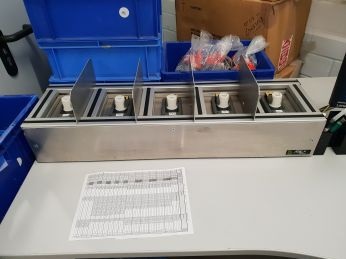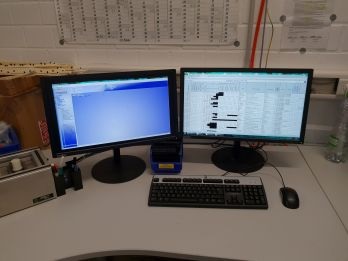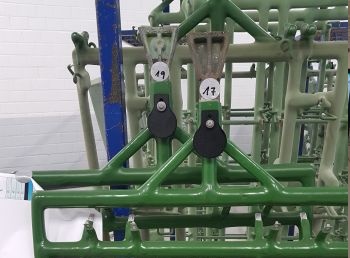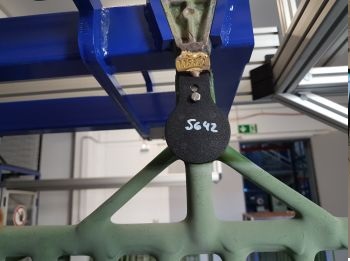
High-bay warehouse management via RFID in the electroplating plant
Fully automatic rack park management with RFID approx. 15,000 racks in the high-bay warehouse
At the beginning is the task. Here were several difficult solutions in the foreground. The environmental conditions on the one hand and the selective reading of up to 14 racks on the other.
Particularly difficult here was a mix of frames that were both chaotically hung on the frame bridges, as well as the chaotic storage in the high-bay warehouse.
The project involved the seamless monitoring of racks throughout the production process (including galvanic processes).
First, the correct assignment of the transponder to the defined racks. There are different frames with 1, 2, 4 or 7 "necks." Basically, each frame is equipped with a transponder. For frames with 2 necks it is unnecessary to equip all necks.
The trick is that the number of necks is scanned across photocells. Thus one identifies the exact frame type together with the EPC number and the stored attributes. Thus, the complete overview is guaranteed.
Transponder (own development)
Here tags were selected which allow a selective reading of the frames.
The criteria required a quick reading of the EPC. It was also required that up to 14 tags be read simultaneously.
In fact, it had to be prevented that there were so-called "side reads" (reading the neighbor tag right/left) as well as "cross reads" (reading the neighbor tag on the opposite side).
Mechanically, the tags had to be bolted to a metal frame (at the neck) and the biggest difficulty was the fact that the tags had to be acid resistant!
In the absence of this special tag on the market, it was decided to make an in-house development to meet the exceptional criteria.
The UHF tag with a diameter of about 50 mm also meets commercial criteria.

Galvanik Transponder for bulk reading
The latest development is a high-performance transponder for bulk readings. This allows several individual racks to be recorded with one reading.
The reading distance can be up to 2m. Attached to the neck of the rack, it can therefore go through the entire process.
When entering the electroplating area, the racks are recorded and given a time stamp. It is also read when leaving.
This means that there is complete transparency about the use of racks.

Initialization Station (own development )
Assign the tag number to the rack with unique number and attributes of the rack. In parallel, 5 transponders of different frame types are described.
Here is the first time saving.
Thus, every frame is unique!
The basic requirement for a chaotic storage!


Fitting the racks with RFID tags
As soon as the racks are equipped with transponders, they are hung on the so-called "Flybar" (blue carrier frame). Here is the next big time saving.
The racks are attached without further assignment, where there is space.
All you have to do is make sure that both the left and right side flybars are filled.
Once the flybar is "full" it will be introduced to the high bay warehouse system.


Fully automatic rack recognition thanks to RFID
As soon as the Flybar is introduced, the "Flybar IN" switch is activated, which starts the reading process - now it gets exciting! In a fraction of a second, the RFID readers (1 master / 3 slave) read out the transponders via 14 antennas evaluating the light barrier signals.
This information is sent to the database and checked for plausibility and compared with the stored data (from the initialization station).
In order to achieve a 100 % reading result AGILLOX has come up with something very special. The DPA system (Dynamic Performance Adjustment) allows the respective parameters of the readers to be individually adjusted per antenna depending on the reading result.
This unique RFID-SW system is looking for the same on the market and allows reading results that were previously considered unattainable.
Now this flybar configuration is stored in the system. Thus, it is stored fully automatically in the next available space.



Storage station with 2 cassette slots. Both places can be used in parallel for in and out.
General information about the storage/retrieval station
- UHF Reader
- High performance antennas (own development )
- High quality coax cable with industrial connectors.
- DPA system (Dynamic Performance Adjustment)
General information about initialization station
UHF Reader
High performance antennas (own development)
General information about transponders (tags)
Acid resistant UHF (868 MHz) transponder
General information about server and control software
All servers and control SW were created and installed by local system houses.

RadioForce has developed a tailor-made solution according to the wishes and requirements of the customer, which today has no equal.
The further production plants have already expressed their interest in the same solution. We are looking forward to it.
A great project in a climate-friendly city.
Your RadioForce Team
